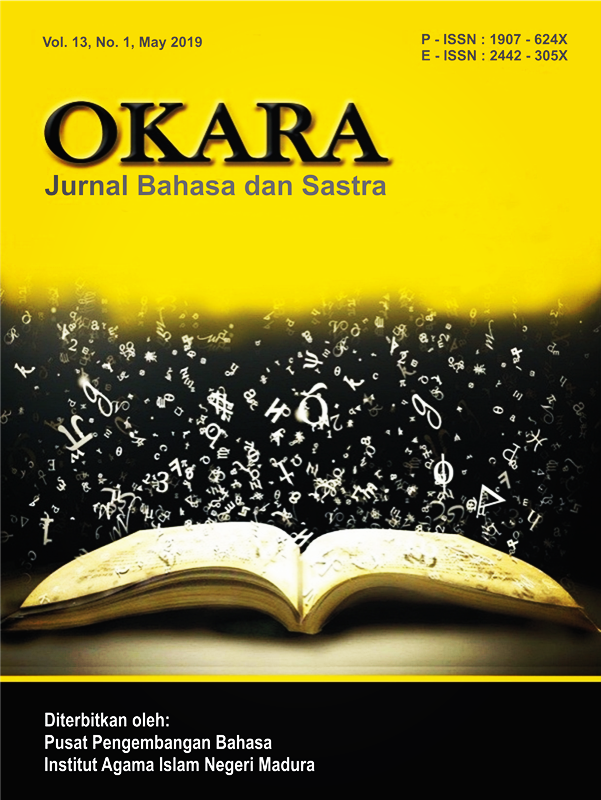الطلبة الفصحاء في الكلام باللغة العربية من منظور علم المعاني :دراسة وصفية في معهد دار العلوم بانيوأنيار الاسلامي باميكاسان
 Abstract views: 165
,
Abstract views: 165
,
 PDF downloads: 172
PDF downloads: 172
Abstract
The most representative indicator of the success of Arabic learning process is the fluency of the students’ speaking by using Arabic. This study aims to determine whether there are students who are fluent in spoken Arabic, to identify the students’ characteristics who are categorically fluent in spoken Arabic, to identify how students gain fluency in spoken Arabic based on Ma’ani science perspective. This is a descriptive qualitative study, the data collected by using interviews, questionnaires, and observation. The data sources were the preachers/teachers and the students who were active and had been active in the Arabic Language Center of Darul Ulum Islamic Boarding School of Banyuanyar. The results of this study revealed: First, students who are fluent in spoken Arabic were classified as fluent after studying Arabic for four months at the Arabic Language Center. Second, there are four indicators of students to be classified as fluent Arabic speakers, the first and the most representative indicator is the proficiency of students in Arabic debate contest in various themes, the second is students’ ability to converse using Arabic in many different situations, the third is the ability to talk using the original Arabic, and the fourth is the students’ ability in a Arabic speech. The way the students gain fluency in spoken Arabic is dependent on the personality of each student. The diligent students tend to have high spirit in practicing conversational Arabic, acquiring and learning Arabic, and also supported by strong intelligence, then they will acquire fluency in speaking Arabic.
Downloads
References
أبو الحسن عليى بن عبد العزيز الشهير. الوساطة بين المتنبي وخصومه. صيدا: مطبعة العرفان, 1331.
أبو نصر إسماعيل بن حماد الجوهري الفارابي. الصحاح تاج اللغة وصحاح العربية. بيروت: دار العلم للملايين, 1987.
أحمد القلقشندي. صبح الأعشى في كتابة الإنشاء. القاهرة: دار الكتب المصرية, 1922.
أحمد الهاشمي. جواهر البلاعة في المعاني والبيان والبديع. الطبعة الثانية عشرة. إندزنيسيا: مكتبة دار احياء الكتب العربية, 1960.
الحباس, محمد الحباس محمد. "كلمات في ميزان الفصاحة العربية". اللّغة العربية 9, عدد 2 (1 أكتوبر، 2007): 53–82.
الخطيب القزويني محمد بن عبد الرحمن جلال الدين. الإيضاح في علوم البلاغة. بيروت: دار الكتب العلمية, 2003.
الفوزان, عبد الرحمن بن إبراهيم, مختار الطاهر حسين, و محمد عبد الخالق محمد فضل. العربية بين يديك كتاب الطالب-ج1. العربية للجميع, 2007.
القرآن العظيم, د.ت.
جمال الدين محمد بن مكرم. لسان العرب. بيروت: دار صادر, د.ت.
ذوقان عبيدات, عبد الرحمن عدس, و كايد عبد الحق. البحث العلمي: مفهومه أدواته أساليبه. الرياض: دار أسامة للنشر والتوزيع, 1997.
سيد محمد مرتضى الحسيني الزبيدي. تاج العروس من جواهر القاموس. كويت: مطبعة الحكومة, 1965.
صدر الدين علي بن أبي الفرج بن الحسن البصري. الحماسة البصرية. القاهرة: مكتبة الخانجي, 1999.
ضياء الدين ابن الأثير. المثل السائر في أدب الكاتب والشاعر. مصر: دار نهضة, د.ت.
عمـــــــــــــار, علــــــــي عمـــــــــــــار علــــــــي. "مراحل تطور اللغة العربية الفصحى". قراءات 1, عدد 1 (30 أبريل، 2008): 79–96.
محمد سيد طنطاوى. التفسير الوسيط للقرآن الكريم. القاهرة: دار نهضة مصر للطباعة والنشر والتوزيع, 1997.
مصطفي الغلاييني. جامع الدروس العربية. بيروت: المكتبة العصرية, 1994.
نور الهادي. "المنهج على أساس المواقف في مركز اللغة العربية بمعهد دار العلوم الاسلامي بانيوأنيار باميكاسان". رسالة الماجستير, جامعة مولانا مالك ابراهيم مالانج, 2011.
Effendy, Ahmad Fuad. "Metodologi Pengajaran Bahasa Arab". Malang: Misykat, 2005.
Hadi, Nurul. "تصميم المنهج المبني على المواقف في مركز اللغة العربية بمعهد دار العلوم بانيوأنيار باميكاسان". Okara & 58; Jurnal Bahasa dan Sastra 9, عدد 2 (2015): 154–181.
Sugiono, D. "Metode Penelitian". Bandung: Alfa Beta, 2000.
The journal operates an Open Access policy under a Creative Commons Attribution-NonCommercial 4.0 International License. Authors who publish with this journal agree to the following terms:
- Authors retain copyright and grant the journal right of first publication with the work simultaneously licensed under a Creative Commons Attribution License that allows others to share the work with an acknowledgement of the work's authorship and initial publication in this journal.
- Authors are able to enter into separate, additional contractual arrangements for the non-exclusive distribution of the journal's published version of the work (e.g., post it to an institutional repository or publish it in a book), with an acknowledgement of its initial publication in this journal.
- Authors are permitted and encouraged to post their work online (e.g., in institutional repositories or on their website) prior to and during the submission process, as it can lead to productive exchanges, as well as earlier and greater citation of published work.





_(1).png)
.png)
.png)
1.png)
.png)
.png)
.png)
_-_Copy_-_Copy.png)





